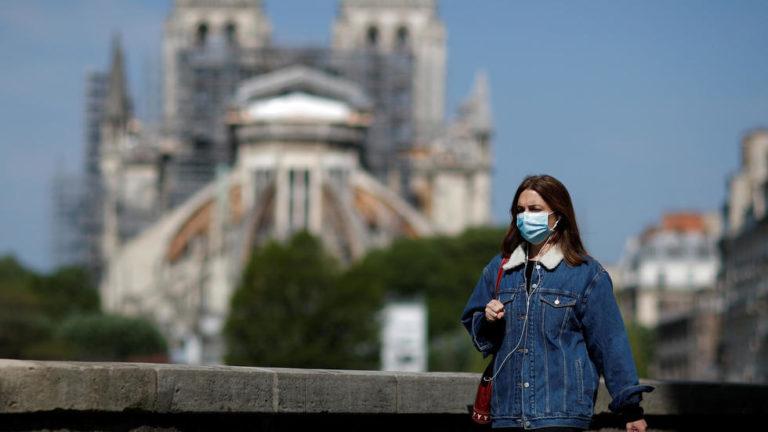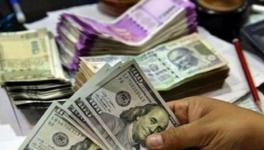There is no Exit from Coronavirus, Only Containment

France bringing an end to lockdown on May 11 but it will not mean instant return to normal life. A woman, wearing a protective face mask, walks past Notre-Dame de Paris Cathedral, Paris, France, April 27, 2020.
From this point, the buck stops with the Modi government, as the country trudges along the Covid highway. The political move to tap into the residual spirit of Indian federalism in our highly polarised polity helped so far, as the central government could inject into its decisions a look of national consensus. Whereas, the central government took all major decisions and most minor decisions.
However, the physical or material conditions vary from state to state while on the other hand, the time is approaching for the central government to make a thorny decision — when or how to restart the economy that was shut down almost overnight.
Clearly, an economy of India’s size won’t start back up simply because the government so decided. The refrain is that the restart will be gradual. But the devil lies in the details. Under what circumstances will businesses be allowed to reopen? It seems certain regions and businesses / industries may be put on a fast track. The MSME sector, which employs 12 crore workers need special attention.
However, defining a yardstick will be difficult because the economy is a complex web of supply chains and interlocking pieces with a dynamics of their own. In an interview with the BBC Radio last week, the owner of Mahindra & Mahindra said he just couldn’t see any possibility of his company becoming operational before May 2021, since, amongst other things, it doesn’t make sense to make cars without the numerous suppliers and sales outlets first reviving and, importantly, until consumer confidence revives.
Clearly, epidemiologists’ recommendations or the government’s decisions will not be the last word. If a manufacturer in Chennai depends on a part made in Ahmedabad, for example, where the virus is still spreading, a government fiat to start production becomes meaningless. Simply put, it is going to take much longer to thaw the economy than it took to freeze it.
Then, there is the co-relation between a phased reopening of the economy and public health benchmarks. The best that can be said about the lockdown is that it probably slowed down the spread of the virus. But we’re chasing a chimera here. The authenticity of the figures available is in serious doubt. No one is to blame because tracking the coronavirus is difficult in such abnormal conditions of lockout.
Today’s New York Times reported that the coronavirus death toll in the US is actually far higher than reported. The FT also came out with a stunning report today that Britain’s actual death toll could be plausibly in the region of 41000, as against hospital death data that show 17,337 people having died.
The plain truth is that there is no “exit strategy” possible out of the lockdown in the absence of a vaccine or a proven therapy. “We will have to learn to live with the virus,” French Prime Minister Édouard Philippe put it starkly on April 28, while outlining his plan to start reopening the country at the National Assembly in Paris, until a vaccine or effective treatment is available.
This stark reality ought to leave with the Indian states a free hand to develop their own road maps and decide either to persist in lockdown or pull themselves out in different ways and at different speed. What cannot be overlooked is that all this is taking place under the threat of a second global wave or outbreak — a disaster scenario.
Epidemics come in waves. In the Spanish flu pandemic of 1918, the deadliest in history, the first wave was nothing in comparison with the virulent second wave, which left a horrific trail. No doubt, this is a Catch-22 situation — whether suppressing the virus further to stall a repeat outbreak or the lifting of restrictions quicker to limit the economic fallout should take precedence. The biggest risk is that you open too fast, too broadly.
The warning from Germany on lockdown easing conveys a sombre message. Only a week since the easing began in Germany with the reopening of shops (with all conceivable precautions put in place with characteristic Teutonic efficiency and thoroughness), it appears that Berlin may have to re-tighten its lockdown because the virus is spreading too fast.
The virus reproduction rate – measuring how many the average person with Covid-19 infects – increased to 1.0. (Any value above 1.0 is seen as leading to exponential increase in infections.) Chancellor Angela Merkel is on record that a rise to 1.2 ( of the so-called “RE number”) could mean hospitals reach a crisis point in July: “If we get to 1.2 people, so everyone is infecting 20 per cent more, out of five people one infects two and the rest one, then we will reach the limit of our healthcare system in July”.
Remember, this is one of the richest countries in the world — and a social democracy with a well developed healthcare system. It is a worrying sign. Surely, there are many variables swirling in the ether, and epidemiology is a complex business.
The bottom line is that with no vaccine or cure insight, the government will have to decide how many deaths would be acceptable to restore a shattered economy. If the “RE” number lifts after an easing of restrictions on 3rd May and we’re forced to back-pedal, the economic damage will be amplified, leave aside the potential to demoralise the public’s resolve.
Mass testing of asymptomatic people appears to be the defining measure of success globally in tackling the virus, but in India, we lack the infrastructure for it. Time and testing are key and the longer a quarantine can be extended the better, and the more testing made available, the easier it would be to properly calibrate a reopening and respond to any new outbreak. No doubt, waiting until comprehensive testing provides a better map of where the infection has spread.
Devi Sridhar, the chair of global public health at Edinburgh Medical School and director of the Global Health Governance program, recently tweeted on the three options open. Sridhar wrote: “There are few short-term options. 1: Let the virus go and thousands die. 2: Lockdown and release cycles which will destroy economy and society. 3: Aggressive test, trace, isolate strategy supported with soft physical distancing.”
Having said that, the horrifying twin-reality still remains to be that an end to lockdown will by no means represent a return to normality, and, equally, a second, far more destructive wave is virtually an unavoidable possibility, notwithstanding the infection-reducing social distancing as a “new normal” in our daily life.
Under the circumstances, while dampening public expectations may not be the best option in politics, public morale is best sustained on the basis of transparent, realistic communication. This is a long haul. Make no mistake that in the absence of a safe and effective vaccine and/or a safe and effective drug to eliminate the COVID-19 infection once it has occurred, our narrative narrows down to a containment strategy attuned to Indian conditions, quintessentially — which, by no means, becomes an exit strategy.
Get the latest reports & analysis with people's perspective on Protests, movements & deep analytical videos, discussions of the current affairs in your Telegram app. Subscribe to NewsClick's Telegram channel & get Real-Time updates on stories, as they get published on our website.























